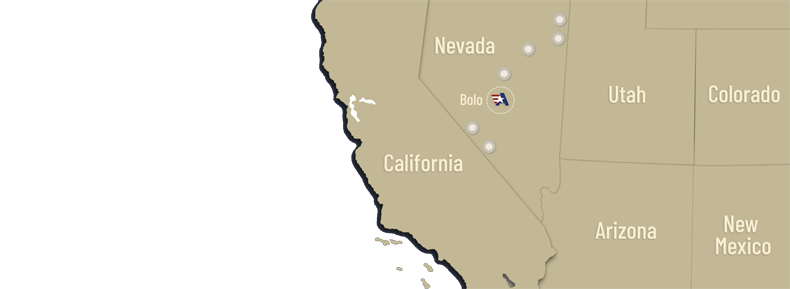Bolo
The Bolo Project is currently farmed-out to Copaur Minerals who have elected to acquire a 75% working interest in the Bolo project by spending an additional US$4 million by December 31, 2024
Gold mineralization at Bolo is Carlin-type, similar to Pinson, Lone Tree/Stonehouse, and Turquoise Ridge/Getchell, all multi-million-ounce Nevada producers, where gold spreads into wall rocks along high-angle structures. Surface sampling at Bolo has defined widespread gold mineralization, associated with jasperoids and iron-stained structures, along two parallel north-south trending faults known as the Mine Fault and the East Fault. Alteration along the Mine Fault has been traced for 2,750 metres, with outcrop sampling returning gold values up to 8.6 g/t gold. The East Fault has been mapped for 2,200 metres and has returned gold values up to 4.7 g/t gold.
The Mine Fault and the East Fault and dozens of altered outcropping and buried cross-faults at Bolo have had very limited drilling and represent excellent exploration targets.
In the summer of 2017, one of the many previously undrilled areas at Bolo was targeted with a modest 14-hole reverse-circulation reconnaissance drilling program totaling 2,806 metres. Eleven (11) holes tested the newly acquired Uncle Sam patented claim that covers a 500 metre strike extension of the south zone of the Mine Fault, an area that was previously drilled with excellent results, including hole BL-38 which returned 133 metres of 1.28 g/t gold from the surface (including 30.5 metres of 3.24 g/t gold), hole BL-39 which returned 89.9 metres of 1.0 g/t gold from surface (including 40.9 metres of 2.05 g/t gold), and hole BL-41 which returned 51.8 metres of 1.27 g/t gold from surface. Drilling on Uncle Sam in 2017 returned 19.8 metres of 0.97 g/t gold (hole BL-55), 33.5 metres of 0.96 g/t gold from surface (hole BL-61), and 57.9 metres of 41.13 g/t silver from the surface (including 7.6 metres of 220 g/t silver) (hole BL-54).
In addition to drilling on Uncle Sam, three (3) holes of the 2017 campaign were drilled to test extensions of the Mine Fault to the west and north. Hole BL-65 was drilled approximately 200 metres north of BL-61 and returned 16.8 metres of 0.66 g/t gold.
All of the gold mineralization intercepted at Bolo is logged as “oxidized” and is Carlin-type mineralization associated with weak silicification and decalcification of Paleozoic sedimentary rocks.


